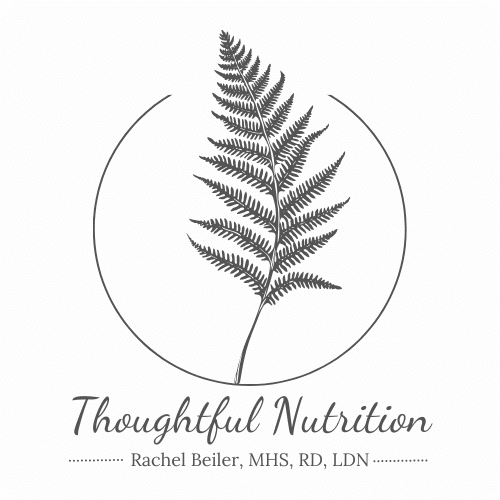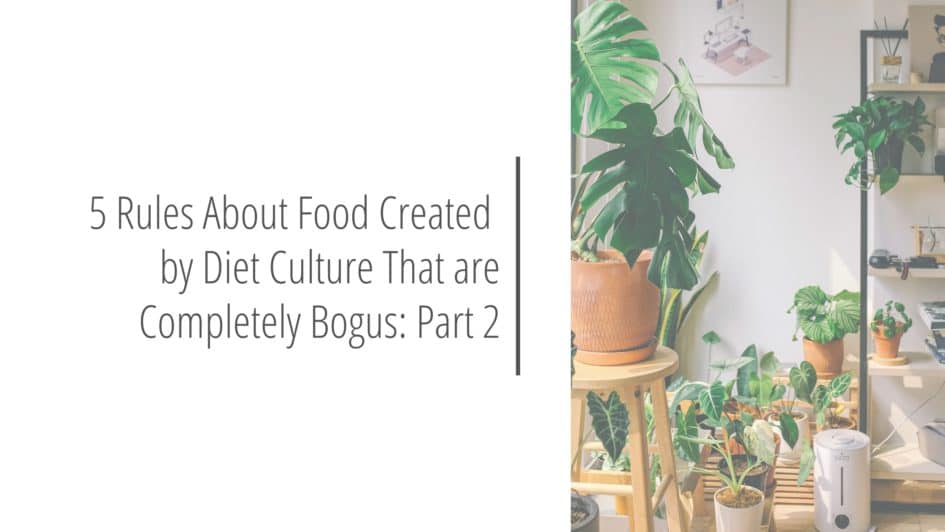Table of Contents
More Rules About Food That Diet Culture Gets Wrong
In Part 1, we broke down some of the most common rules about food created by diet culture and why they are total nonsense. But the list doesn’t end there. Diet culture is relentless, constantly inventing new ways to control how we eat and making us feel guilty for simply enjoying food.
The good news? You don’t have to follow any of these rules. Let’s debunk more of diet culture’s bogus food rules and reclaim our relationship with food.
1. Fruit Has Too Much Sugar
Why This Rule Exists
Somewhere along the line, sugar became public enemy number one. Diet culture took this and ran with it, lumping all sources of sugar together—whether it’s from a candy bar or an apple. This rule is rooted in fear and misunderstanding about how our bodies process sugar.
Why It’s Bogus
Fruit is not the enemy. The sugar in fruit is naturally occurring and comes packaged with fiber, vitamins, minerals, and antioxidants that are essential for your health. Fiber slows down sugar absorption, preventing blood sugar spikes. Plus, fruits offer a range of health benefits, from boosting immunity to improving digestion.
Demonizing fruit is a prime example of diet culture’s black-and-white thinking. In reality, fruit can be a nutritious and delicious part of a balanced diet.
2. Always Choose Fat-Free or Low-Fat
Where Did This Rule Come From?
This rule dates back to the low-fat craze of the 80s and 90s, when fat was falsely blamed for weight gain and heart disease. But we’ve since learned that not all fats are created equal, and cutting out fat entirely is not the answer.
Why It’s Bogus
Our bodies need fat to function properly. Dietary fat is essential for brain function, hormone production, and nutrient absorption. Full-fat products can also help keep you fuller for longer.
Choosing foods based solely on their fat content ignores the bigger picture of nutrition. Instead, focus on including a variety of fats, like those from nuts, seeds, avocados, and olive oil, which offer many health benefits.
3. Only Eat Whole Grains
Why This Rule Exists
Diet culture loves to villainize refined grains, painting whole grains as the only “healthy” option. But while whole grains do typically offer more fiber and nutrients, that doesn’t mean refined grains are inherently bad.
Why It’s Bogus
Refined grains, like white rice or pasta, can absolutely be part of a balanced diet. They can be easier to digest for some people and provide quick energy when needed. Plus, foods like white rice or pasta are often fortified with essential vitamins and minerals.
Labeling one type of grain as “good” and another as “bad” creates unnecessary food anxiety. Instead, focus on variety and what feels good for your body.
4. Avoid “Empty Calories”
What’s the Deal with Empty Calories?
The term “empty calories” is often used to describe foods that are low in nutrients but high in calories, like sweets and snacks. Diet culture tells us to avoid these foods entirely, but this rule ignores the joy and satisfaction food can bring.
Why It’s Bogus
Food is about more than just nutrition. It’s about culture, pleasure, and connection. Sometimes you eat for nourishment, and sometimes you eat for fun, and both are valid. Labeling foods as “empty” suggests they have no value, which isn’t true.
You’re allowed to eat foods just because they taste good, not because they meet some arbitrary standard of nutrition.
5. Limit White or Beige Foods
Where Did This Come From?
This rule is rooted in the belief that colorful foods are more nutritious, while white or beige foods are “bad” or unhealthy. But this oversimplifies nutrition and unfairly demonizes many nourishing foods.
Why It’s Bogus
White and beige foods, like potatoes, bread, rice, cauliflower, and bananas, can provide essential nutrients, including fiber, potassium, and vitamins. Potatoes, for example, are high in vitamin C and potassium. Bread and rice can be excellent sources of energy, especially for active individuals.
Nutrition isn’t all about color; it’s about variety, balance, and meeting your body’s needs. Don’t let diet culture’s color-coded rules dictate your food choices.
Breaking Free from Even More Bogus Rules About Food
Diet culture thrives on rigid rules, leaving little room for individuality or joy when it comes to food. But here’s the truth: food is not meant to be feared or controlled. It’s meant to nourish your body and soul, to be enjoyed, and to be a part of life’s experiences. Food connects us to our culture, traditions, and loved ones. It’s more than just fuel, it’s comfort, celebration, and creativity.
By questioning these food rules, you’re taking the first step toward food freedom. It’s about unlearning years of diet culture’s conditioning and rediscovering your own relationship with food. It’s okay if this feels challenging. Diet culture is loud and pervasive, but you have the power to tune it out.
One powerful way to break free is by embracing curiosity over judgment. Instead of asking, “Is this food good or bad?” try asking, “How does this food make me feel?” Does it energize you? Does it satisfy a craving? Does it bring you joy? By shifting your focus from rules to how food feels in your body, you begin to rebuild trust in yourself.
Remember, there’s no one-size-fits-all when it comes to health. You get to define what works best for you. What nourishes one person may not nourish another, and that’s perfectly okay. Health is about finding balance, flexibility, and joy in food, not rigid rules or restrictions.
Ready to Break Free?
Breaking free from diet culture’s food rules isn’t about giving up on health, it’s about redefining health on your own terms. It’s about balance, variety, and trusting your body’s needs. Health is not about perfection; it’s about progress. It’s about nurturing your body, mind, and soul in ways that feel sustainable and joyful.
Redefining health means letting go of the guilt and shame diet culture imposes. It means honoring your hunger, savoring satisfaction, and allowing yourself the full range of eating experiences without judgment.
Embrace food freedom by practicing self-compassion. Remind yourself that it’s okay to make mistakes, to eat more than you planned, or to enjoy dessert just because it tastes good. Self-compassion allows you to move past guilt and learn from each eating experience.
Most importantly, listen to your body. Your body is wise and capable of guiding you toward what it needs. Trusting your hunger, fullness, and cravings may take time, especially if you’ve been following rigid rules for years. Be patient with yourself as you relearn how to tune in.
There are no rules you need to follow. Food freedom is about rediscovering the joy of eating without fear, guilt, or restriction. It’s about living fully, enjoying meals, and embracing the pleasure food can bring.
Thanks for reading!
Rachel Beiler, MHS, RD, LDN


Leave a Reply